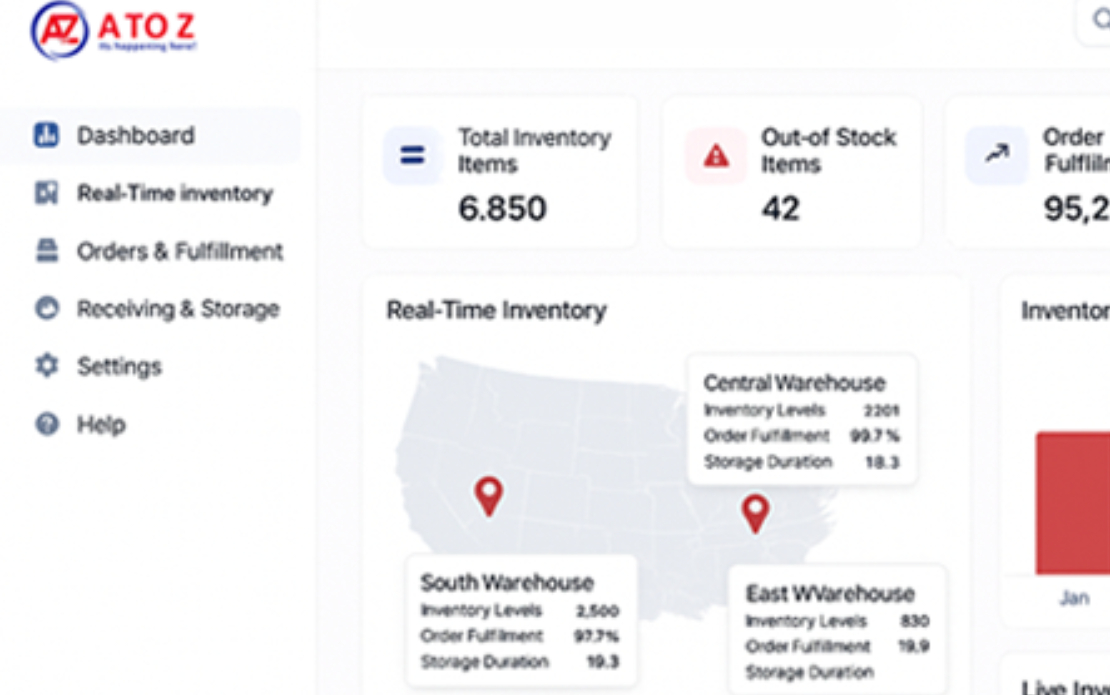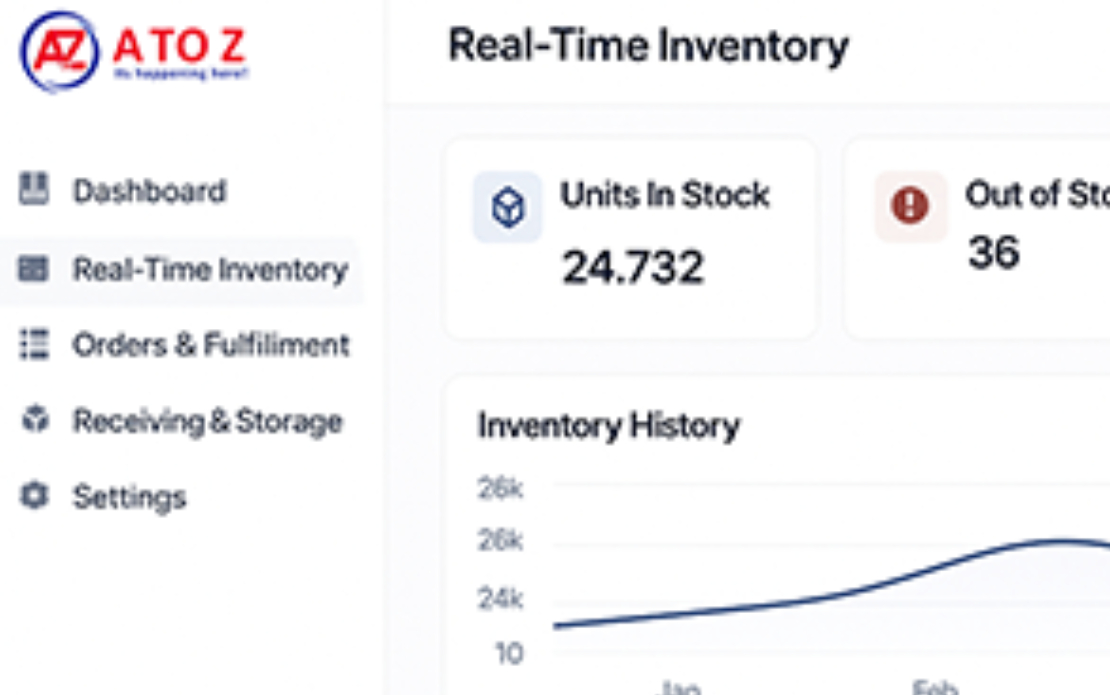
Inventory and Warehouse Management Solution
Challenge
AToZ trade is one of the leading kitchenware B2B and B2C retailer in mena region, that supplies a wide range of products from cookware and cutlery to kitchen appliances. As customer demand grew and product lines diversified, managing inventory across multiple warehouses and retail locations became increasingly challenging. The existing manual and semi-automated processes led to inaccurate stock counts, inefficiencies in order fulfillment, and delays in replenishment. In response, AToZ kitchenware sought an integrated and comprehensive inventory and warehouse management solution that could easily scale with the company’s growth and adapt to new product lines and additional locations. The project aimed to:
Improve inventory accuracy across warehouses by implement real-time tracking to reduce discrepancies and ensure optimal stock levels.
Streamline warehouse operations by automating key warehouse processes such as receiving, storage, and order fulfillments to enhance efficiency.
Improve replenishment processes using automated alerts and demand forecasting to facilitate timely replenishment and better manage supplier relationships.
Stock visibility across warehouses using dashboards and reporting tools to provide actionable insights into inventory turnover, order processing times, and overall operational performance.
Automate order generation and tracking from key suppliers for timely replenishment.
AToZ trade is one of the leading kitchenware B2B and B2C retailer in mena region, that supplies a wide range of products from cookware and cutlery to kitchen appliances. As customer demand grew and product lines diversified, managing inventory across multiple warehouses and retail locations became increasingly challenging. The existing manual and semi-automated processes led to inaccurate stock counts, inefficiencies in order fulfillment, and delays in replenishment. In response, AToZ kitchenware sought an integrated and comprehensive inventory and warehouse management solution that could easily scale with the company’s growth and adapt to new product lines and additional locations. The project aimed to:
Improve inventory accuracy across warehouses by implement real-time tracking to reduce discrepancies and ensure optimal stock levels.
Streamline warehouse operations by automating key warehouse processes such as receiving, storage, and order fulfillments to enhance efficiency.
Improve replenishment processes using automated alerts and demand forecasting to facilitate timely replenishment and better manage supplier relationships.
Stock visibility across warehouses using dashboards and reporting tools to provide actionable insights into inventory turnover, order processing times, and overall operational performance.
Automate order generation and tracking from key suppliers for timely replenishment.
Solution
Serverless Backend Architecture
* Google cloud functions to handle specific tasks like inventory tracking, warehouse operations, order management and reporting.
* Google cloud endpoints development for seamless RESTful API integration with third-part systems.
* Asynchronous processing leveraging cloud pub/sub for handling tasks item status change for fulfilment process, order status change, replenishment forecasting and for managing returns.
* Cloud storage solution for storing relational data including orders, inventory and user data.
Real-Time Inventory Management
* Dynamic label generation functionality to identify and track each item within warehouse to facilitate easy tracking.
* Implemented barcode scanning at all receiving and storage points to automatically update inventory levels.
* Quality Inspection by handling staff to access and submit the inspection report via mobile app.
* Implemented automated stock adjustments to reconcile between physical counts and system records in real-time.
* Developed automated workflows for warehouse inbound and outbound processes including item receiving, rack placement, order picking, packing, and shipping.
* Implemented dynamic allocation of storage space based on product type, dimensions, and seasonal demand.
* Return item workflow to initiate return claim process with supplier including description, pictures and warranty.
Replenishment and Demand Forecasting
* Developed automated threshold alerts to trigger reordering when stock levels drop below predefined limits.
API Integration Layer
* Developed real-time inventory synchronization with e-commerce platform via RESTful APIs to ensure consistent information across channels.
Reporting & Analytics Dashboard
* Developed dashboards to display key metrics such as inventory turnover, order fulfillment times, and stock accuracy.
* Return rate analysis tool to provides insights into return rates, common reasons for returns, and trends.
* Inventory impact analysis tool to provides insights into stock items that are resalable, disposable or damaged.
* Supplier reports for raised purchase orders with status and invoices.
Data Security and Compliance
* End-to-end encryption for sensitive data in transit and at rest.
* Secure APIs with authentication and authorization using JWT.
* Compliance with industry standards for data privacy.
Serverless Backend Architecture
* Google cloud functions to handle specific tasks like inventory tracking, warehouse operations, order management and reporting.
* Google cloud endpoints development for seamless RESTful API integration with third-part systems.
* Asynchronous processing leveraging cloud pub/sub for handling tasks item status change for fulfilment process, order status change, replenishment forecasting and for managing returns.
* Cloud storage solution for storing relational data including orders, inventory and user data.
Real-Time Inventory Management
* Dynamic label generation functionality to identify and track each item within warehouse to facilitate easy tracking.
* Implemented barcode scanning at all receiving and storage points to automatically update inventory levels.
* Quality Inspection by handling staff to access and submit the inspection report via mobile app.
* Implemented automated stock adjustments to reconcile between physical counts and system records in real-time.
* Developed automated workflows for warehouse inbound and outbound processes including item receiving, rack placement, order picking, packing, and shipping.
* Implemented dynamic allocation of storage space based on product type, dimensions, and seasonal demand.
* Return item workflow to initiate return claim process with supplier including description, pictures and warranty.
Replenishment and Demand Forecasting
* Developed automated threshold alerts to trigger reordering when stock levels drop below predefined limits.
API Integration Layer
* Developed real-time inventory synchronization with e-commerce platform via RESTful APIs to ensure consistent information across channels.
Reporting & Analytics Dashboard
* Developed dashboards to display key metrics such as inventory turnover, order fulfillment times, and stock accuracy.
* Return rate analysis tool to provides insights into return rates, common reasons for returns, and trends.
* Inventory impact analysis tool to provides insights into stock items that are resalable, disposable or damaged.
* Supplier reports for raised purchase orders with status and invoices.
Data Security and Compliance
* End-to-end encryption for sensitive data in transit and at rest.
* Secure APIs with authentication and authorization using JWT.
* Compliance with industry standards for data privacy.
Results
Enhanced Inventory Accuracy
Real-time scanning reduced stock discrepancies by 85%.
Automated replenishment ensured optimal stock levels and minimized overstock/stock-out scenarios.
Improved Warehouse Efficiency
Streamlined order picking and packing processes cut order processing times by 40%.
Optimized storage layouts increased warehouse utilization by 30%.
Better Data-Driven Decision Making
Real-time dashboards and reporting provided actionable insights that improved inventory turnover and reduced holding costs.
Forecasting tools enabled proactive demand planning, aligning inventory with seasonal trends and promotional activities.
Seamless Integration
Integration with suppliers and e-commerce systems ensured consistent data across channels, improving overall operational visibility.
Enhanced Inventory Accuracy
Real-time scanning reduced stock discrepancies by 85%.
Automated replenishment ensured optimal stock levels and minimized overstock/stock-out scenarios.
Improved Warehouse Efficiency
Streamlined order picking and packing processes cut order processing times by 40%.
Optimized storage layouts increased warehouse utilization by 30%.
Better Data-Driven Decision Making
Real-time dashboards and reporting provided actionable insights that improved inventory turnover and reduced holding costs.
Forecasting tools enabled proactive demand planning, aligning inventory with seasonal trends and promotional activities.
Seamless Integration
Integration with suppliers and e-commerce systems ensured consistent data across channels, improving overall operational visibility.

